Costa Rica is one of the planet’s most biodiverse destinations, packing a whopping 5% of the world’s biodiversity (read: plant and animal life) into just 0.03% of the Earth’s surface. In other words, the country houses more (much more) than its fair share of species, including eight of our favorite exotic animals in Costa Rica!
From brilliantly colored toxic frogs and croaking toucans to rhino relatives and not-so-slothful sloths, we’re sharing a few of the weird, the interesting, and the exotic. Let us know which ones you’ve already spotted and which are still on your list!
Amphibian: Red-Eyed Tree Frogs
Agalychnis callidryas
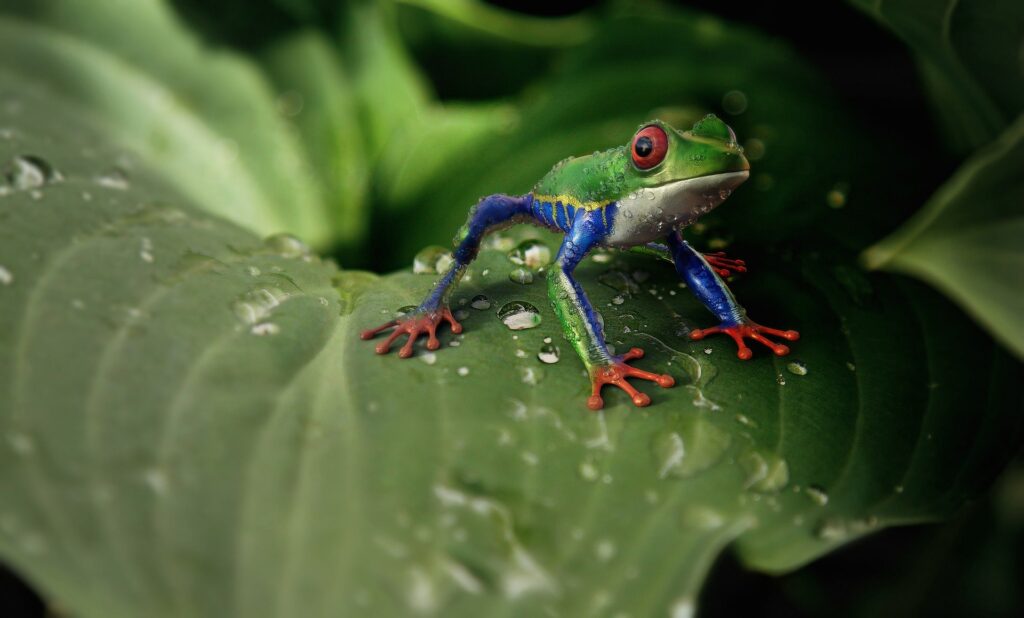 One of the most iconic (and adorable) exotic animals in Costa Rica, the red-eyed tree frog is a beloved rainforest amphibian known for its neon-green body, electric blue-striped sides, orange webbed feet, and brilliant red eyes.
One of the most iconic (and adorable) exotic animals in Costa Rica, the red-eyed tree frog is a beloved rainforest amphibian known for its neon-green body, electric blue-striped sides, orange webbed feet, and brilliant red eyes.
They are ambush predators (their favorite snacks are flies, moths, and crickets) with sticky tongues (and feet). However, despite their brilliant coloring, red-eyed tree frogs are not poisonous. (Want to know about poisonous frogs? Read down our list!)
Fun Fact: Scientists believe that red-eyed tree frogs evolved their attention-catching, scarlet eyes to startle predators for a few critical seconds, thus allowing the frogs to escape predation. This evolution, which other animals also employ, is appropriately known as “startle coloration.”
Mammal: Sloths (Two- and Three-Toed)
Choloepus hoffmanni and Bradypus variegatus
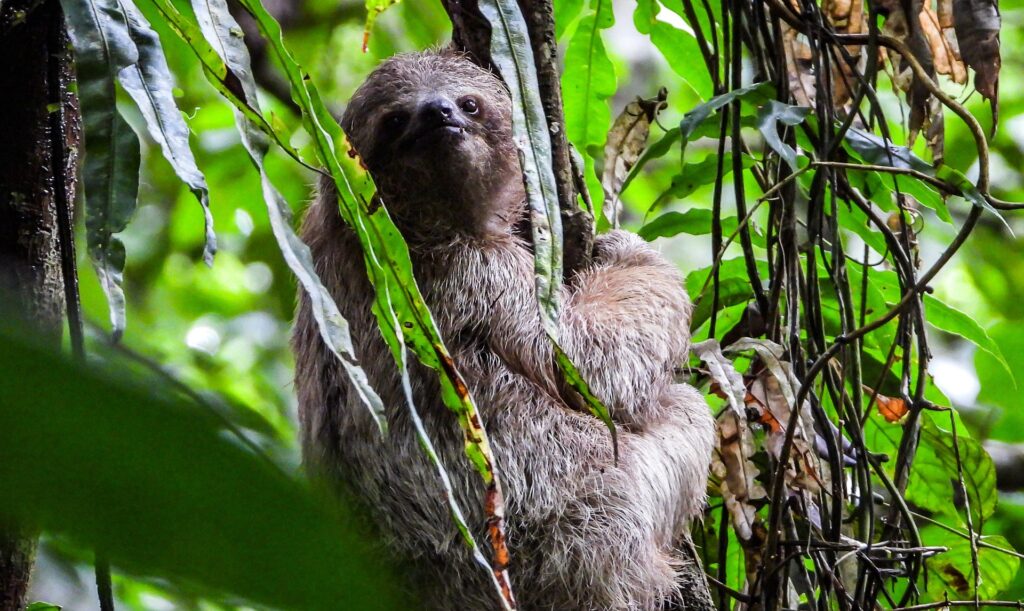 Costa Rica is home to both Hoffman’s two-toed sloths and brown-throated three-toed sloths, which, contrary to popular belief, are not actually slothful. Indeed, these adorable vegetarians have adapted their slow movements to account for their low-calorie, leaf-forward diets.
Costa Rica is home to both Hoffman’s two-toed sloths and brown-throated three-toed sloths, which, contrary to popular belief, are not actually slothful. Indeed, these adorable vegetarians have adapted their slow movements to account for their low-calorie, leaf-forward diets.
If you’re itching to spot a sloth, know that Hoffman’s two-toed sloths are nocturnal, meaning they’re awake at night, while brown-throated sloths are diurnal – they are awake by day and night. That means, for tours, it’s usually easier to see three-toed sloths, which are also a bit more active than their two-toed counterparts.
Fun Fact: Though we tend to group sloths together as “sloths,” Costa Rica’s two species are not only different species, but completely different genera AND families. They belong only to the same order!
Bird / Reptile: Keel-Billed Toucans
Ramphastos sulfuratus
 Meet the real Toucan Sam! Keel-billed toucans, also known as rainbow-billed toucans, are one of the world’s most colorful birds. Their orange, green, red, and blue bills account for about a third of the birds’ total size!
Meet the real Toucan Sam! Keel-billed toucans, also known as rainbow-billed toucans, are one of the world’s most colorful birds. Their orange, green, red, and blue bills account for about a third of the birds’ total size!
But toucan bills are light and hollow – made of reinforced bone, covered in keratin (think: human nails) – and so, they don’t hinder flight. In fact, the keel-billed toucan uses its bill for several purposes: In addition to gathering food, fencing with rivals, and attracting a mate, scientists postulate that these massive bills can even help with temperature regulation. Talk about multi-tasking!
Fun Fact: What do you think a toucan sounds like? The reality is that toucans all sound vastly different from one another. But keel-billed toucans could almost earn a spot on our list of exotic animals in Costa Rica for their call alone: a throaty croak that will have you swearing that you’re being serenaded an incredibly vociferous frog calling for a mate. (Click through for a soundbite!)
Reptile: Basilisk Lizards
Basiliscus (Genus)
 There are three types of basilisk lizards in Costa Rica: the common basilisk (Basiliscus basiliscus), the emerald basilisk (Basiliscus plumifrons), and the brown basilisk (Basiliscus vittatus). They’re all a joy to spot, although the emerald basilisk, with its celestial blue spots, is perhaps the showiest.
There are three types of basilisk lizards in Costa Rica: the common basilisk (Basiliscus basiliscus), the emerald basilisk (Basiliscus plumifrons), and the brown basilisk (Basiliscus vittatus). They’re all a joy to spot, although the emerald basilisk, with its celestial blue spots, is perhaps the showiest.
Their genus name, Basiliscus, is derived from the Greek basiliskos, or “little king.” While this may refer to a white “crown” on its head, it’s also possible that it’s a nod to the mythical King of Serpents: The legendary basilisk, which features prominently in Harry Potter and the Chamber of Secrets, and was rumored to turn humans and animals to stone with a single glance.
Fun Fact: Basilisk lizards are sometimes known as “Jesus Christ lizards,” due to their ability to walk on water. Kind of. Basilisks are incredibly fast; this, paired with their light weight, allows them to skitter across the water’s surface. Go fast enough, and they don’t sink. It’s really a sight to see!
Insect: Morpho Butterflies
Morpho (Genus)
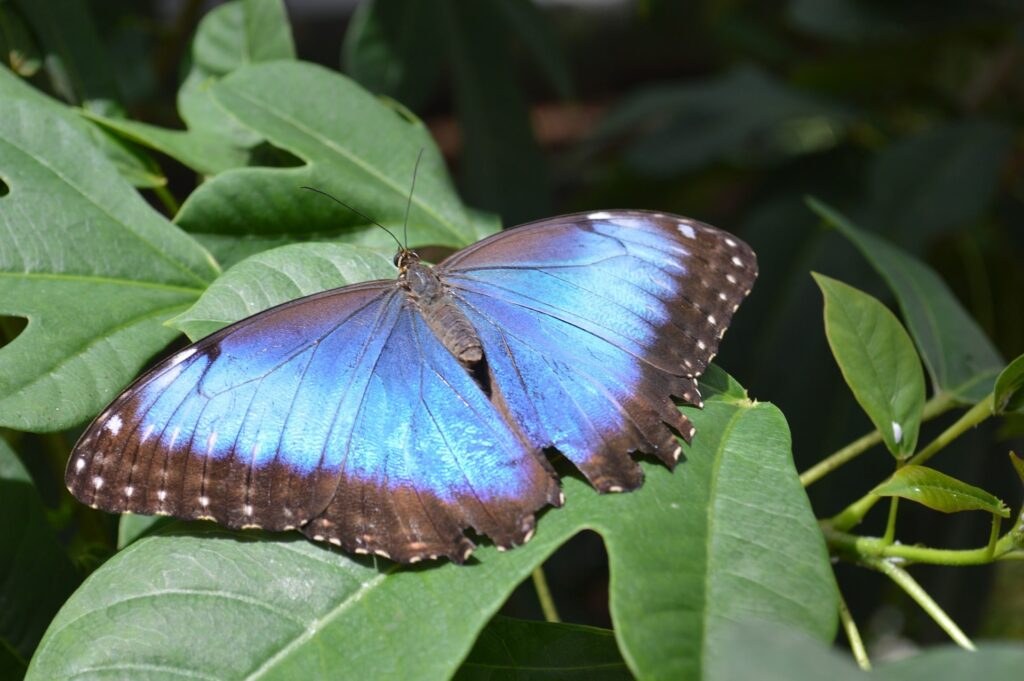 One of the most impressive and showy butterflies on Earth, blue morpho butterflies are classified into over a half-dozen species, including many sub-species. You’ll find this flashy flutterer throughout the country, although blue morphos do favor forests and fields near water sources, including rivers and the ocean.
One of the most impressive and showy butterflies on Earth, blue morpho butterflies are classified into over a half-dozen species, including many sub-species. You’ll find this flashy flutterer throughout the country, although blue morphos do favor forests and fields near water sources, including rivers and the ocean.
Blue morphos employ two defense tactics to protect themselves: First, they practice a “flash and dazzle” – a dance of light-on-blue and fluttering wings, designed to confuse predators – and second, they use mimicry, via their closed wing “eye spots,” to convince predators that they’re confronting a larger animal (likely a bird).
Fun Fact: Believe it or not, morpho butterflies aren’t blue! In fact, most of nature’s blue hues aren’t actually blue. It comes down to science but long story short, the morpho’s blue hues are not courtesy of pigment (true blue) but rather structural coloration, which essentially absorbs all colors except blue, which is then reflected back toward our eye. Pretty cool, right?
Amphibian: Poison-Dart Frogs
Dendrobatidae (Family)
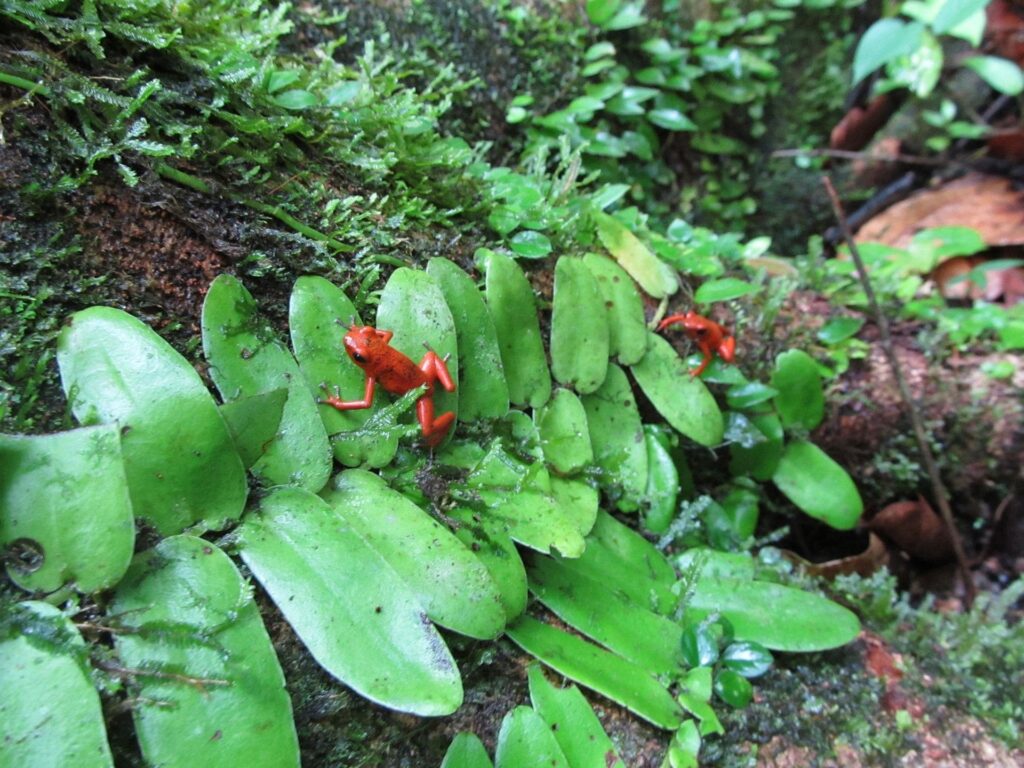 Poison dart frogs are among some of our favorite exotic animals in Costa Rica, and we have several to spot! Among them are the strawberry poison dart frog (Dendrobates pumilio), green-and-black poison dart frog (Dendrobates auratus), the blue jeans or granular poison frog (Oophaga granulifera), the rainforest rocket frog (Silverstoneia flotator), the lovely poison frog (Phyllobates lugubris), and the Golfodulcean poison frog (Phyllobates vittatus).
Poison dart frogs are among some of our favorite exotic animals in Costa Rica, and we have several to spot! Among them are the strawberry poison dart frog (Dendrobates pumilio), green-and-black poison dart frog (Dendrobates auratus), the blue jeans or granular poison frog (Oophaga granulifera), the rainforest rocket frog (Silverstoneia flotator), the lovely poison frog (Phyllobates lugubris), and the Golfodulcean poison frog (Phyllobates vittatus).
When you spot poison dart frogs in the wild, you’ll be immediately struck by their hues – some of Mother Nature’s brightest colors! These brilliant palettes are what scientists call “aposematic coloration,” or coloring that serves to warn, “I’m poisonous!” While Costa Rica’s poison dart frogs aren’t that poisonous, you still wouldn’t want to get hit by a dart dipped in their toxins! (That’s where the family gets their name.)
Fun Fact: The Golfodulcean poison frog (Phyllobates vittatus) is endemic to Costa Rica, which means that it is found only in Costa Rica. Though animals don’t recognize national borders, this little guy somehow still doesn’t cross into nearby Panama!
Mammal: Baird’s Tapir
Tapirus bairdii
 It’s like Mother Nature’s mashup between a rhinoceros (body), an elephant (snout), and a horse (eyes) – except, it’s none of the above. Welcome to the world of the endangered Baird’s tapir, one of Costa Rica’s gentler giants at 500-875 pounds. (They can win in a tussle with a crocodile, though. They’re not that gentle!)
It’s like Mother Nature’s mashup between a rhinoceros (body), an elephant (snout), and a horse (eyes) – except, it’s none of the above. Welcome to the world of the endangered Baird’s tapir, one of Costa Rica’s gentler giants at 500-875 pounds. (They can win in a tussle with a crocodile, though. They’re not that gentle!)
Baird’s tapir have fallen prey to habitat loss and other threats, earning them a spot on the IUCN Red List. That said, you can still spot them at Corcovado National Park, Tenorio Volcano National Park (home to the famous Celeste River), Monteverde Cloud Forest, La Selva Reserve, and other locations. In fact, local conservation projects are working to grow their populations, so the chances of a sighting are now better than they have been in decades.
Fun Fact: Believe it or not, the gentle Baird’s tapir is a relative of the critically endangered black rhinoceros and the white rhinoceros. They’re in the same order, which means they’re as closely related as our two- and three-toed sloths!
Golden Orb Weaver Spiders
Nephila clavipes
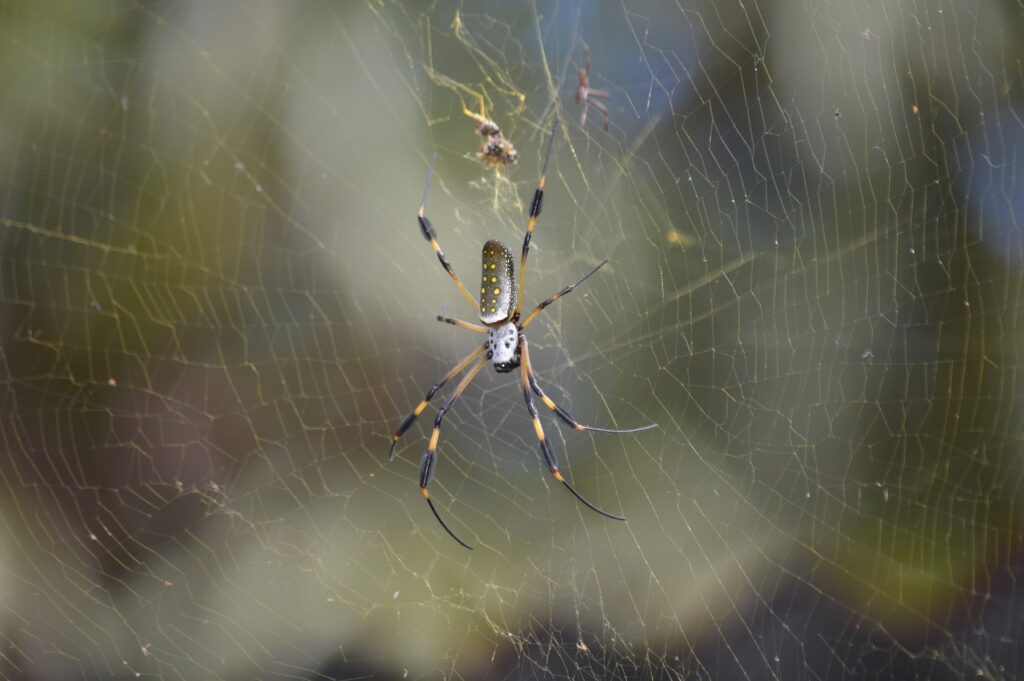 While there are many golden orb weaver spiders in the world, Central America hosts only one: Nephila clavipes, an awe-inspiring arachnid with astounding engineering chops. Their webs showcase their mastery, combining sticky inner webs to catch prey with non-sticky outer webs, constructed in 3-D to deter predators from all angles.
While there are many golden orb weaver spiders in the world, Central America hosts only one: Nephila clavipes, an awe-inspiring arachnid with astounding engineering chops. Their webs showcase their mastery, combining sticky inner webs to catch prey with non-sticky outer webs, constructed in 3-D to deter predators from all angles.
True to name, golden orb weavers literally spin gold: Their incredible webbed homes are woven from yellow silk pigment. In addition to being beautiful in the sun, the color is irresistible to the weaver’s prey.
Fun Fact: Golden orb weavers build incredibly super strong webs that can span up to 2 meters (6.5 feet) wide – that’s 40 times the size of a large female! (Males are 1/50 the mass of a female, by the way!) By comparison, imagine building a house that measured 220 feet wide, or about 2/3 of a city block!
An Educational Place to Call Home: Inspire a Love of Learning in Costa Rica & CRIA
If you’re reading this, it’s safe to say that you probably live in Costa Rica, at least in part, because of the country’s incredible biodiversity. Every day is a learning experience and there’s always something that instills wonder and inspires CRIA students.
And that’s why we love exploring the wide world of exotic animals in Costa Rica. Discover our greater world. Make memories. And help your children find their inspiration, their interests, and their passions, just like we do at CRIA.
We don’t want you to just take our word for it, though. Come and visit. Tour our campus. Poke your head into one of our classes, a swim class, or an extracurricular. Get a feel for our community. See if it inspires you.
Whether you’re wondering about tuition & fees or special education in Costa Rica, cafeteria nutrition or the admissions process, we’re here to help. And when you’re ready to take the next step – to come, visit, and get your questions answered in person – we’d love to welcome you!
Get in touch to schedule a campus visit. We look forward to it!

